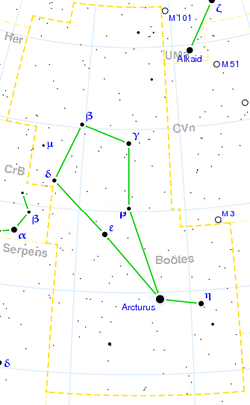Tau Boötis
| Observation data Epoch J2000.0 Equinox J2000.0 | |
|---|---|
| Constellation | Boötes |
| Right ascension | 13h 47m 15.74s[1] |
| Declination | +17° 27′ 24.9″[1] |
| Apparent magnitude (V) | 4.50[2] |
| Characteristics | |
| Spectral type | F6 IV[2] |
| U−B color index | 0.04 |
| B−V color index | 0.48[2] |
| R−I color index | 0.24 |
| Variable type | Variable star |
| Astrometry | |
| Radial velocity (Rv) | -15.6 km/s |
| Proper motion (μ) | RA: -479.53 ± 0.16[1] mas/yr Dec.: 53.49 ± 0.13[1] mas/yr |
| Parallax (π) | 64.03 ± 0.19[1] mas |
| Distance | 50.9 ± 0.2 ly (15.62 ± 0.05 pc) |
| Absolute magnitude (MV) | 3.53 |
| Details | |
| Mass | 1.3 / 0.4 M☉ |
| Radius | 1.331 ± 0,027 R☉ |
| Luminosity | 3.0[2] L☉ |
| Surface gravity (log g) | 4.30[2] cgs |
| Temperature | 6,360[3] K |
| Metallicity | 210%[citation needed] |
| Rotation | 3.31 days[3] |
| Rotational velocity (v sin i) | 14 km/s |
| Age | 1.6–2.3 [4] Gyr |
| Other designations | |
| Database references | |
| SIMBAD | data |
| Data sources: | |
| Hipparcos Catalogue, CCDM (2002), Bright Star Catalogue (5th rev. ed.) | |
| Database references | |
| SIMBAD | data |
Tau Boötis (τ Boo, τ Boötis) is a yellow-white dwarf approximately 51 light-years away[1] in the constellation of Boötes. The system is also a binary star system, with the secondary star being a red dwarf. As of 1999, an extrasolar planet has been confirmed to be orbiting the primary star.
Stellar components
The system is a binary. The primary component is a yellow-white dwarf (spectral type F7 V) and secondary is a dim red dwarf (spectral type M2 V). The system is relatively nearby, distance being about 51 light years. The primary star should be easily visible to the unaided eye under dark skies.
The primary star, Tau Boötis A is a yellow-white dwarf. It is 20% more massive than our Sun and thus is somewhat brighter and hotter. It has a radius 1.9 times solar, and is probably about 1300 million years old. Since it is more massive than the Sun, its lifespan is shorter being less than 6000 million years. Tau Bootis is the first star apart from the sun to be observed changing the polarity of its magnetic field.[5] It is also listed as a suspected variable star.
Tau Boötis B (with a capital B, as opposed to the planet) is a dim red dwarf orbiting the primary star at a distance of 240 AU. One orbit around the primary would take thousands of years to complete.
Planetary system
In 1996 a planet, designated as Tau Boötis b, was discovered orbiting the primary star.[6] There are also some indications of another, more distant, planet orbiting the star. In an unusual case of role-reversal, it appears that Tau Boötis' rotation has been tidally locked to Tau Boötis b.[7] The planet was discovered by a team of astronomers led by Geoff Marcy and R. Paul Butler.[6]
| Companion (in order from star) |
Mass | Semimajor axis (AU) |
Orbital period (days) |
Eccentricity | Inclination | Radius |
|---|---|---|---|---|---|---|
| b | 6±0.28 MJ | 0.0481 ± 0.028 | 3.312463 ± 0.000014 | 0.023 ± 0.015 | 44.5 ± 1.5° | — |
References
- ↑ 1.0 1.1 1.2 1.3 1.4 1.5 van Leeuwen, F. (2007). "Validation of the new Hipparcos reduction". Astronomy and Astrophysics 474 (2): 653–664. arXiv:0708.1752. Bibcode:2007A&A...474..653V. doi:10.1051/0004-6361:20078357. Vizier catalog entry
- ↑ 2.0 2.1 2.2 2.3 2.4 Mallik, Sushma V. (December 1999), "Lithium abundance and mass", Astronomy and Astrophysics 352: 495–507, Bibcode:1999A&A...352..495M
- ↑ 3.0 3.1 Strassmeier, Klaus G. (September 2009), "Starspots", The Astronomy and Astrophysics Review 17 (3): 251–308, Bibcode:2009A&ARv..17..251S, doi:10.1007/s00159-009-0020-6
- ↑ Mamajek, Eric E.; Hillenbrand, Lynne A. (2008). "Improved Age Estimation for Solar-Type Dwarfs Using Activity-Rotation Diagnostics". The Astrophysical Journal 687 (2): 1264–1293. arXiv:0807.1686. Bibcode:2008ApJ...687.1264M. doi:10.1086/591785.
- ↑ Donati, J.-F. et al. (2008). "Magnetic cycles of the planet-hosting star Tau Boötis". Monthly Notices of the Royal Astronomical Society 385 (3): 1179–1185. arXiv:0802.1584. Bibcode:2008MNRAS.385.1179D. doi:10.1111/j.1365-2966.2008.12946.x.
- ↑ 6.0 6.1 Butler, R. Paul et al. (1997). "Three New 51 Pegasi Type Planets". The Astrophysical Journal Letters 474 (2): L115–L118. Bibcode:1997ApJ...474L.115B. doi:10.1086/310444.
- ↑ Walker, G. A. H. et al. (2008). "MOST detects variability on tau Bootis possibly induced by its planetary companion". Astronomy and Astrophysics 482 (2): 691–697. arXiv:0802.2732. Bibcode:2008A&A...482..691W. doi:10.1051/0004-6361:20078952.
- ↑ Butler, R. P. et al. (2006). "Catalog of Nearby Exoplanets". The Astrophysical Journal 646 (1): 505–522. arXiv:astro-ph/0607493. Bibcode:2006ApJ...646..505B. doi:10.1086/504701.
External links
- "VizieR: HR 5185". Centre de Données astronomiques de Strasbourg. Retrieved 2009-05-15.
- "VizieR: CCDM J13473+1727". Centre de Données astronomiques de Strasbourg. Retrieved 2009-05-15.
- "Aladin Previewer: Tau Boötis". Centre de Données astronomiques de Strasbourg. Retrieved 2009-05-15.
- Schirber, Michael (23 May 2005). "Role Reversal: Planet Controls a Star". SPACE.com. Retrieved 2008-06-25.
- "Notes for star Tau Boo". The Extrasolar Planets Encyclopaedia. Retrieved 2008-06-25.
- "Tau Boötis 2". SolStation. Retrieved 2008-06-25.
- "Tau Bootis". Extrasolar Visions. Retrieved 2008-06-25.
- "Tau Bootis". The Planet Project. Retrieved 2008-06-25.
Coordinates: ![]() 13h 47m 15.7s, +17° 27′ 25″
13h 47m 15.7s, +17° 27′ 25″
| ||||||||||||||||||||||||||||||||||||||||||||||||||||
| ||||||||||||||||||||||||||
